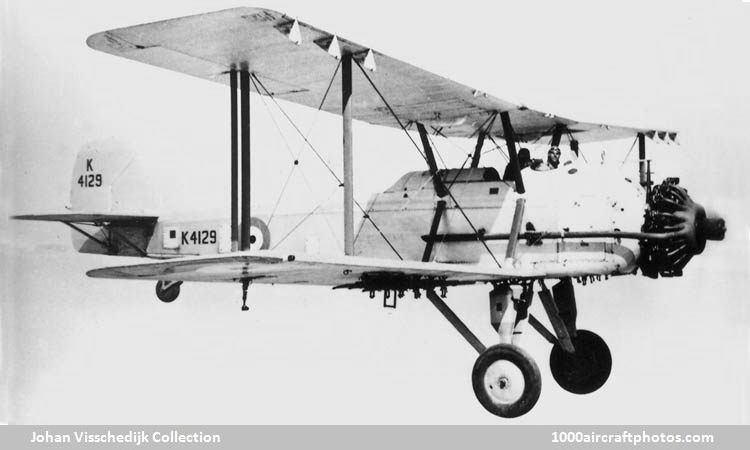12/31/2010. Remarks by Johan Visschedijk: "On December 21, 1932, the converted Mk.I Vildebeest, s/n S1714, was sent on an extended tour of RAF stations in the Middle East, the Sudan and East Africa, on trials as a general-purpose aircraft. Later, the Air Ministry issued specification 21/33 for this class, and the satisfactory completion of the tour by S1714 and flight tests at Martlesham led to an initial order for 51 GP Vildebeests on December 8, 1933. As the role was quite different from that of the torpedo-bomber Vildebeests, a new name was selected, Vincent.
The Vincent replaced the Wapitis and Fairey IIIFs which had served overseas for so long. The rugged airframe of the Vildebeest/Vincent class with the robust and reliable Bristol Pegasus IIM3 air-cooled radial engine fitted the requirement admirably. The Vincent was a three-seat type with an auxiliary fuel tank underslung between the landing gear legs in place of the torpedo of the Vildebeest. This external tank was the one distinguishing feature of the Vincent, and with it the range was extended to 1,250 mls (2,012 km).
Maximum disposable load was about 4,000 lb (1,814 kg), and specific bomb load was 1,000 lb (454 kg). Comprehensive tropical equipment was provided, and specific military equipment included message pick-up gear for Army co-operation, pyrotechnics, sleeping bags, emergency rations, and wireless telegraph and telephone with collapsible masts for ground operation.
The first Vincent was a converted Vildebeest Mk II, K4105, type-tested at Martlesham to the revised GP specification 16/34, and it appeared in the RAF Display of 1935. There was a large conversion of Vildebeests to Vincents and considerable production of new airframes, the total operating as Vincents being 197.
Vincents became operational at the end of 1934 with 8 Squadron at Aden replacing Fairey IIIFs, and superseded the Wapitis of 55 and 84 Squadrons in Iraq and of 31 Squadron in India. In 1937 a flight of five Vincents of 47 Squadron with two Vickers Valentias of 216 Squadron flew from Khartoum to West Africa and back, thus confirming the suitability of the Vincent for long-range operation in tropical conditions.
At the beginning of WW II Vildebeests and Vincents had to stand in for later aircraft not available immediately for service.
The Vildebeest was the only torpedo-bomber of RAF Coastal Command, and Vincents were in action in East Africa in 1940-41 and in Iraq in 1941. The two Vildebeest Squadrons, 36 and 100, were left to face the Japanese invasion of Singapore in 1941, but as this was overland, their resistance, however gallant, was unavailing and their losses heavy. Two Vildebeests of 36 Squadron continued the fight in Java, but were lost in Sumatra when trying to reach Burma.
Although ungainly by modern standards, with their square-cut outlines, Vildebeests and Vincents were endeared to the RAF more for their stout construction, which stood up well in the trying heat and dust in Iraq, India and the Sudan, than for any startling performance. The family represented a typical Pierson design, no doubt influenced by the production team, which disliked curves and streamlines difficult and costly in manufacture. The Vincent was the last to use the Vickers metal-framed construction, with a tubular fuselage and tail, and wings of steel spars with double tubular booms and wandering webs, with light-alloy tubular ribs."
